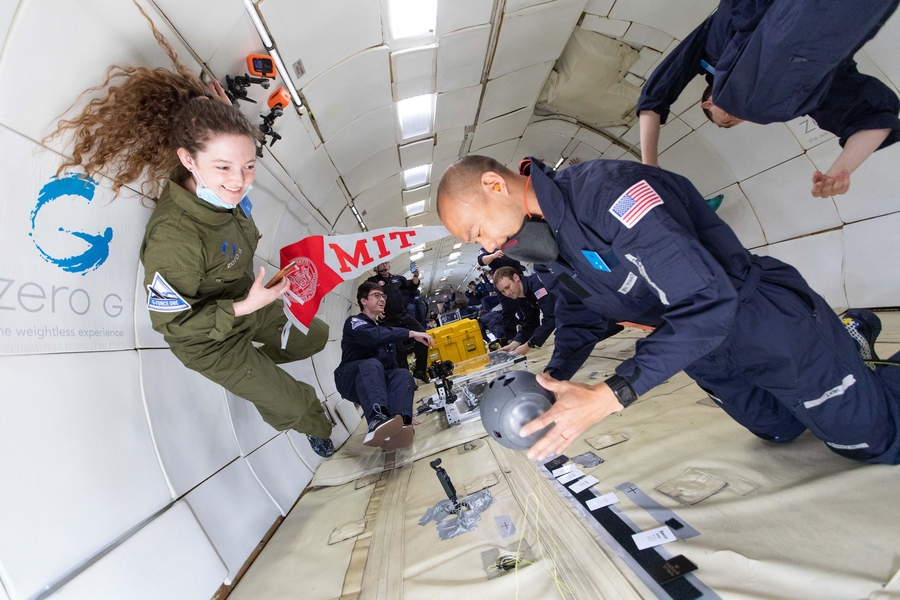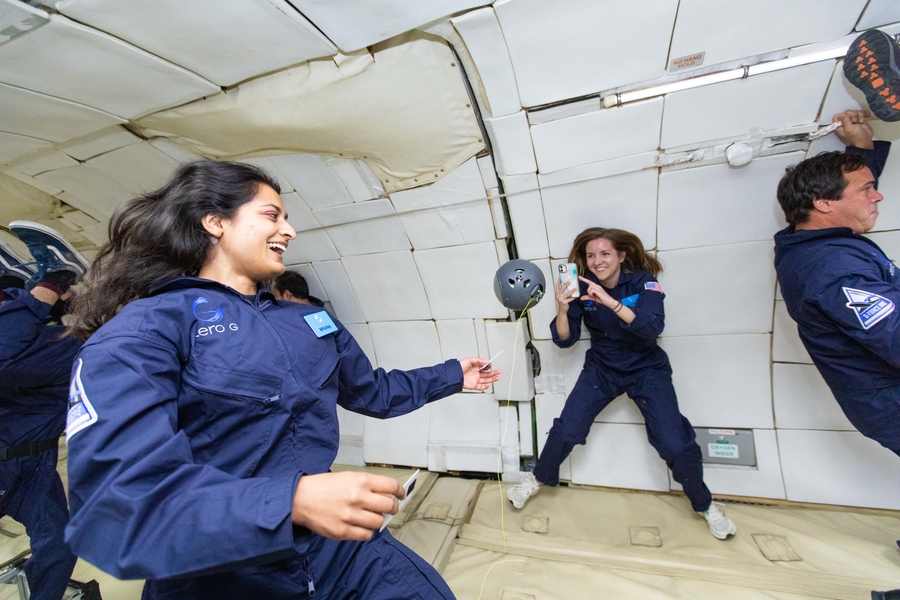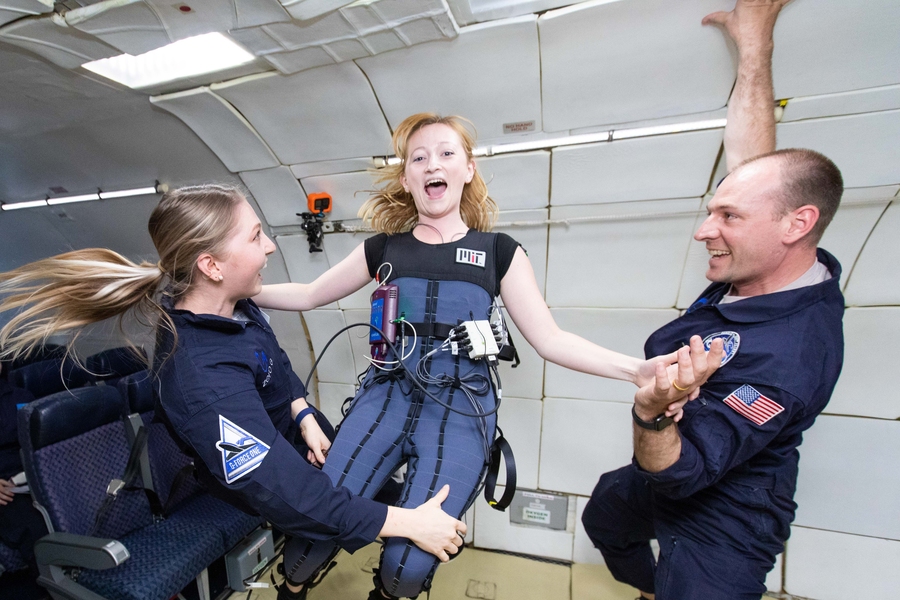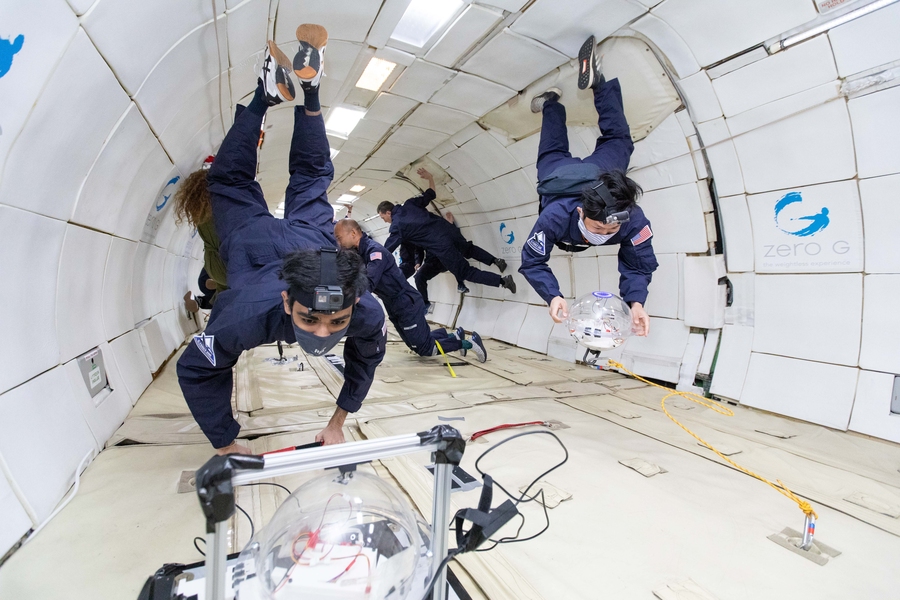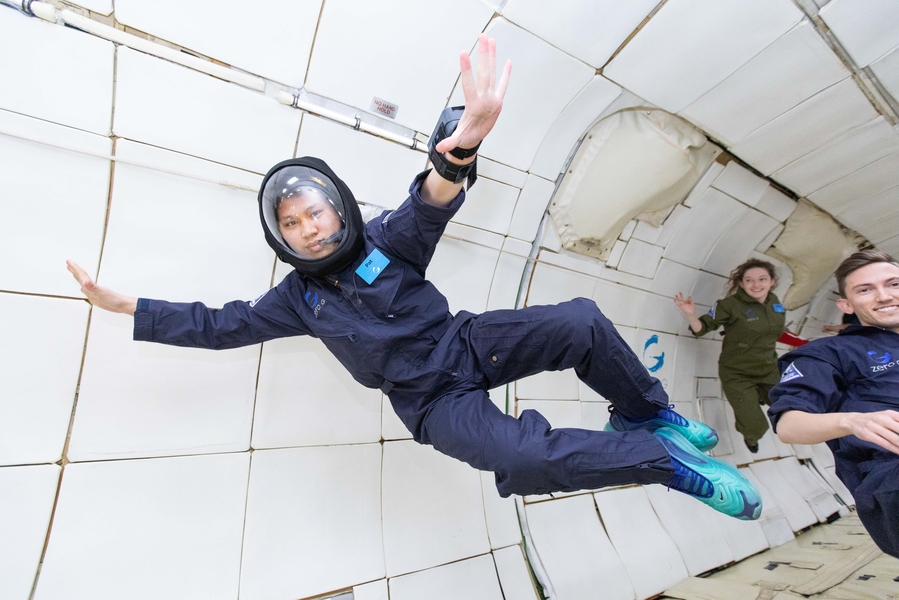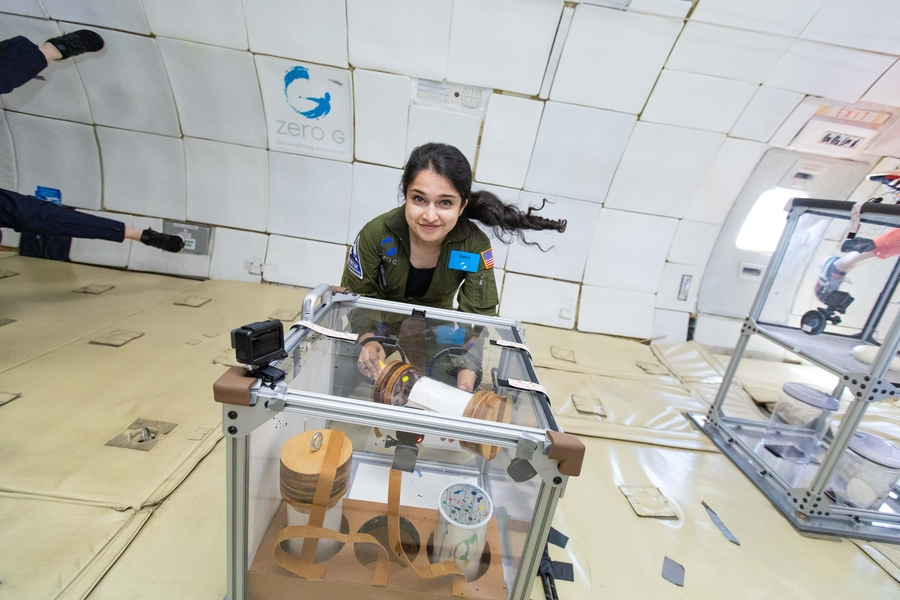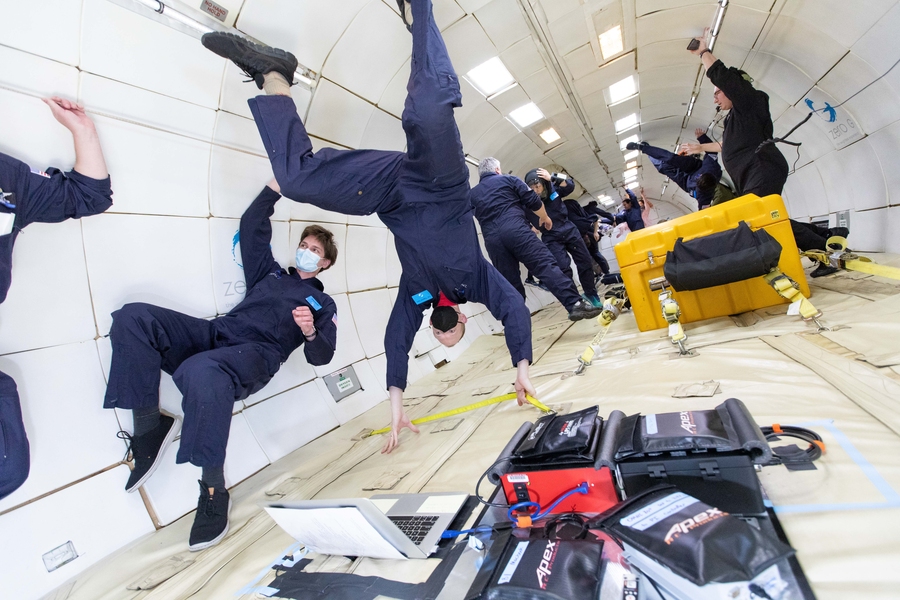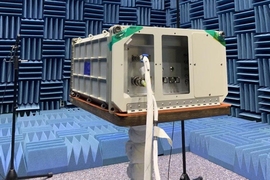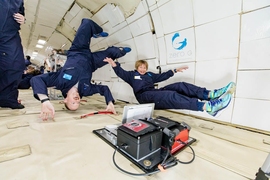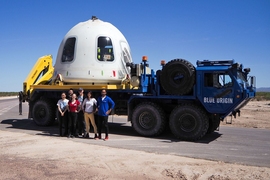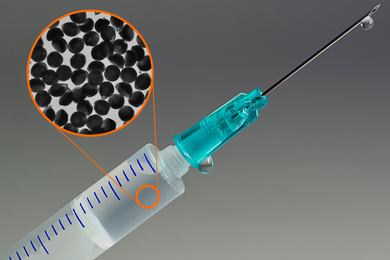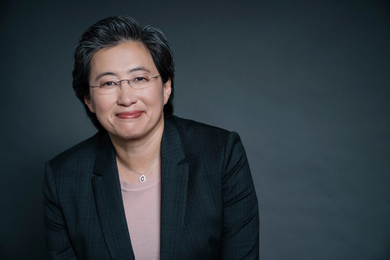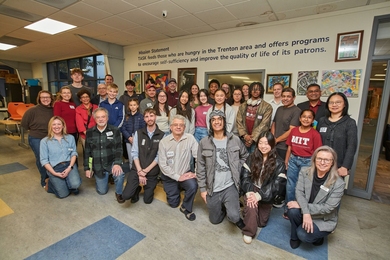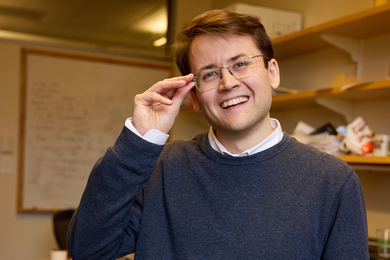As a not-so-distant future that includes space tourism and people living off-planet approaches, the MIT Media Lab Space Exploration Initiative is designing and researching the activities humans will pursue in new, weightless environments.
Since 2017, the Space Exploration Initiative (SEI) has orchestrated regular parabolic flights through the ZERO-G Research Program to test experiments that rely on microgravity. This May, the SEI supported researchers from the Media Lab; MIT's departments of Aeronautics and Astronautics (AeroAstro), Earth, Atmospheric and Planetary Sciences (EAPS), and Mechanical Engineering; MIT Kavli Institute; the MIT Program in Art, Culture, and Technology; the MIT Computer Science and Artificial Intelligence Laboratory (CSAIL); the John A. Paulson School of Engineering and Applied Sciences (SEAS) at Harvard University; the Center for Collaborative Arts and Media at Yale University; the multi-affiliated Szostak Laboratory, and the Harvard-MIT Program in Health Sciences and Technology to fly 22 different projects exploring research as diverse as fermentation, reconfigurable space structures, and the search for life in space.
Most of these projects resulted from the 2019 or 2020 iterations of MAS.838 / 16.88 (Prototyping Our Space Future) taught by Ariel Ekblaw, SEI founder and director, who began teaching the class in 2018. (Due to the Covid-19 pandemic, the 2020 flight was postponed, leading to two cohorts being flown this year.)
“The course is intentionally titled ‘Prototyping our Sci-Fi Space Future,’” she says, “because this flight opportunity that SEI wrangles, for labs across MIT, is meant to incubate and curate the future artifacts for life in space and robotic exploration — bringing the Media Lab's uniqueness, magic, and creativity into the process.”
The class prepares researchers for the realities of parabolic flights, which involves conducting experiments in short, 20-second bursts of zero gravity. As the course continues to offer hands-on research and logistical preparation, and as more of these flights are executed, the projects themselves are demonstrating increasing ambition and maturity.
“Some students are repeat flyers who have matured their experiments, and [other experiments] come from researchers across the MIT campus from a record number of MIT departments, labs, and centers, and some included alumni and other external collaborators,” says Maria T. Zuber, MIT’s vice president for research and SEI faculty advisor. “In short, there was stiff competition to be selected, and some of the experiments are sufficiently far along that they’ll soon be suitable for spaceflight.”
Dream big, design bold
Both the 2020 and 2021 flight cohorts included daring new experiments that speak to SEI’s unique focus on research across disciplines. Some look to capitalize on the advantages of microgravity, while others seek to help find ways of living and working without the force that governs every moment of life on Earth.
Che-Wei Wang, Sands Fish, and Mehak Sarang from SEI collaborated on Zenolith, a free-flying pointing device to orient space travelers in the universe — or, as the research team puts it, a 3D space compass. “We were able to perform some maneuvers in zero gravity and confirm that our control system was functioning quite well, the first step towards having the device point to any spot in the solar system,” says Sarang. “We'll still have to tweak the design as we work towards our ultimate goal of sending the device to the International Space Station!”
Then there’s the Gravity Loading Countermeasure Skinsuit project by Rachel Bellisle, a doctoral student in the Harvard-MIT Program in Health Sciences and Technology and a Draper Fellow. The Skinsuit is designed to replicate the effects of Earth gravity for use in exercise on future missions to the moon or to Mars, and to further attenuate microgravity-induced physiological effects in current ISS mission scenarios. The suit has a 10-plus-year history of development at MIT and internationally, with prior parabolic flight experiments. Skinsuit originated in the lab of Dava Newman, who now serves as Media Lab director.
“Designing, flying, and testing an actual prototype is the best way that I know of to prepare our suit designs for actual long-term spaceflight missions,” says Newman. “And flying in microgravity and partial gravity on the ZERO-G plane is a blast!”
Alongside the Skinsuit are two more projects flown this spring that involve wearables and suit prototypes: the Peristaltic Suit developed by Media Lab researcher Irmandy Wicaksono and the Bio-Digital Wearables or Space Health Enhancement project by Media Lab researcher Pat Pataranutaporn.
“Wearables have the potential to play a critical role in monitoring, supporting, and sustaining human life in space, lessening the need for human medical expert intervention,” Pataranutaporn says. “Also, having this microgravity experience after our SpaceCHI workshop ... gave me so many ideas for thinking about other on-body systems that can augment humans in space — that I don’t think I would get from just reading a research paper.”
AgriFuge, from Somayajulu Dhulipala and Manwei Chan (graduate students in MIT's departments of Mechanical Engineering and AeroAstro, respectively), offers future astronauts a rotating plant habitat that provides simulated gravity as well as a controllable irrigation system. AgriFuge anticipates a future of long-duration missions where the crew will grow their own plants — to replenish oxygen and food, as well as for the psychological benefits of caring for plants. Two more cooking-related projects that flew this spring include H0TP0T, by Larissa Zhou from Harvard SEAS, and Gravity Proof, by Maggie Coblentz of the SEI — each of which help demonstrate a growing portfolio of practical “life in space” research being tested on these flights.
The human touch
In addition to the increasingly ambitious and sophisticated individual projects, an emerging theme in SEI’s microgravity endeavor is a focus on approaches to different aspects of life and culture in space — not only in relation to cooking, but also architecture, music, and art.
Sanjana Sharma of the SEI flew her Fluid Expressions project this spring, which centers around the design of a memory capsule that functions as both a traveler’s painting kit for space and an embodied, material reminder of home. During the flight, she was able to produce three abstract watercolor paintings. “The most important part of this experience for me,” she says, “was the ability to develop a sense of what zero gravity actually feels like, as well as how the motions associated with painting differ during weightlessness.”
Ekblaw has been mentoring two new architectural projects as part of the SEI’s portfolio, building on her own TESSERAE work for in-space self-assembly: Self Assembling Space Frames by SEI’s Che-Wei Wang and Reconfigurable space structures by Martin Nisser of MIT CSAIL. Wang envisions his project as a way to build private spaces in zero-gravity environments. “You could think of it like a pop-up tent for space,” he says. “The concept can potentially scale to much larger structures that self-assemble in space, outside space stations.”
Onward and upward
Two projects that explore different notions of the search for life in space include Ø-scillation, a collaboration between several scientists at the MIT Kavli Institute, Media Lab, EAPS, and Harvard; and the Electronic Life-detection Instrument (ELI) by Chris Carr, former MIT EAPS researcher and current Georgia Tech faculty member, and Daniel Duzdevich, a postdoc at the Szostak Laboratory.
The ELI project is a continuation of work within Zuber’s lab, and has been flown on previous flights. “Broadly, our goals are to build a low-mass life-detection instrument capable of detecting life as we know it — or as we don't know it,” says Carr. During the 2021 flight, the researchers tested upgraded hardware that permits automatic real-time sub-nanometer gap control to improve the measurement fidelity of the system — with generally successful results.
Microgravity Hybrid Extrusion, led by SEI’s mission integrator, Sean Auffinger, alongside Ekblaw, Nisser, Wang, and MIT Undergraduate Research Opportunities Program student Aiden Padilla, was tested on both flights this spring and works toward building in situ, large-scale space structures — it’s also one of the selected projects being flown on an ISS mission in December 2021. The SEI is also planning a prospective "Astronaut Interaction" mission on the ISS in 2022, where artifacts like Zenolith will have the chance to be manipulated by astronauts directly.
This is a momentous fifth anniversary year for SEI. As these annual flights continue, and the experiments aboard them keep growing more advanced, researchers are setting their sights higher — toward designing and preparing for the future of interplanetary civilization.
